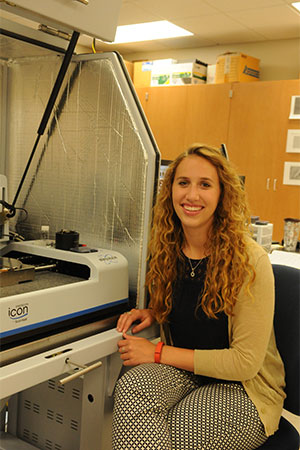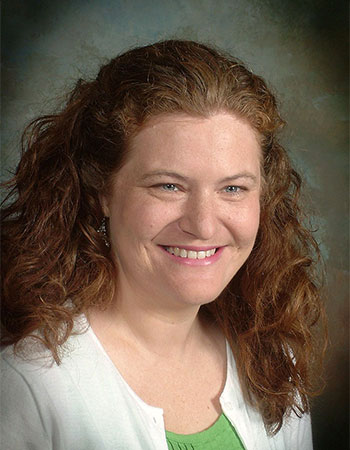The research team of Hope College chemistry professor Dr. Mary (Beth) Anderson and senior Monica Ohnsorg has received top national recognition: the 2016 Undergraduate Award in Inorganic Chemistry presented to researchers at a primarily undergraduate institution by the American Chemical Society’s (ACS) Division of Inorganic Chemistry.
They were presented the award during the ACS’s 251st National Meeting and Exposition, held in San Diego, California, on Sunday-Thursday, March 13-17. The division also honored teams at research institutions and corporate, federal or national laboratories. Researchers from colleges and universities across the country competed for the awards.
 “The national award from the American Chemical Society recognizes the great contribution
of Dr. Anderson and Monica Ohnsorg's research towards the field of inorganic chemistry.
This award speaks volumes of the excellent mentoring by Dr. Anderson on the professional
development of Monica Ohnsorg,” said Dr. Kenneth Brown, associate professor of chemistry
and department chair, who nominated Anderson and Ohnsorg for the award. “One of the
cornerstones of the Chemistry Department is research, and Hope College has provided
support and an atmosphere to allow our research program to thrive. To compete against
other well-known undergraduate institutions and win this award is a tremendous accomplishment.
This is one reason that Hope College is one of the premier institutions to conduct
research with undergraduate students.”
“The national award from the American Chemical Society recognizes the great contribution
of Dr. Anderson and Monica Ohnsorg's research towards the field of inorganic chemistry.
This award speaks volumes of the excellent mentoring by Dr. Anderson on the professional
development of Monica Ohnsorg,” said Dr. Kenneth Brown, associate professor of chemistry
and department chair, who nominated Anderson and Ohnsorg for the award. “One of the
cornerstones of the Chemistry Department is research, and Hope College has provided
support and an atmosphere to allow our research program to thrive. To compete against
other well-known undergraduate institutions and win this award is a tremendous accomplishment.
This is one reason that Hope College is one of the premier institutions to conduct
research with undergraduate students.”
Anderson, an assistant professor of chemistry and Towsley  Research Scholar, and the Hope students in her research group are investigating nanoscale
thin films composed of metal-organic frameworks (MOFs), which are nanoporous, crystalline
materials with applications ranging from gas storage to drug delivery. She has been
investigating the properties and formation of the films for the past several years,
working collaboratively with Hope students since joining the faculty in 2010.
Research Scholar, and the Hope students in her research group are investigating nanoscale
thin films composed of metal-organic frameworks (MOFs), which are nanoporous, crystalline
materials with applications ranging from gas storage to drug delivery. She has been
investigating the properties and formation of the films for the past several years,
working collaboratively with Hope students since joining the faculty in 2010.
Ohnsorg, a chemistry major from Chanhassen, Minnesota, who is minoring in engineering and mathematics, has been conducting the research with Anderson since the 2013 spring semester of her freshman year, including full-time during the past three summers and part-time during the school year.
They have been examining the fundamental formation of MOFs as thin films deposited on surfaces using atomic force microscopy, and were the first to establish a growth mechanism for an iconic MOF system (HKUST-1). They have also studied ways to tailor film morphology using different deposition temperatures, and have been using the fundamental knowledge of film growth to integrate MOF thin films into device architectures on transparent substrates for chemical sensing applications.
Both Anderson and Ohnsorg have received both external and campus recognition for excellence.
External support of Anderson’s research has included a three-year grant from the National Science Foundation (NSF); a two-year grant from the American Chemical Society (ACS) Petroleum Research Fund; and an instrumentation award, received with Dr. Jennifer Hampton of the physics faculty, from the NSF for an atomic force microscope essential for studying the films. Hope named her a Towsley Research Scholar in 2013, the same year that she received the Mary J. DeYoung Faculty Mentoring, Advising and Teaching Award from the college’s Division for the Natural and Applied Sciences. One of her previous research students, 2013 graduate Meagan Elinski, twice received honorable mention in the NSF’s prestigious Graduate Research Fellowship program, in 2014 and 2015.
Ohnsorg finished second in the country in the 2015 NDConnect national undergraduate nanotechnology research competition, and was a semifinalist the previous year. Also this spring, she received honorable mention recognition in the National Science Foundation’s Graduate Research Fellowship Program. During the ACS’s national conference last year, she and senior Brandon Bowser of Midland won the “best poster” prize for their presentation of their research with Anderson, in the event’s COLL Student Poster Contest. She is the lead author of an article about her research published in the ACS Journal, Langmuir, and among the authors of an article about the work published in the journal Thin Solid Films. She is an Arnold and Mabel Beckman Scholar at the college, receiving support for her research program during the summers of 2014 and 2015 and during the school year in between, and also received the college’s Jaecker Chemistry Scholarship. She will attend graduate school in the fall, pursuing research in polymer chemistry and biomaterials.
The American Chemical Society is a nonprofit organization chartered by the U.S. Congress. With more than 158,000 members, ACS is the world’s largest scientific society and a global leader in providing access to chemistry-related research through its multiple databases, peer-reviewed journals and scientific conferences.